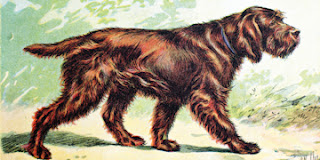Breed of the Week: The Wirehaired Pointing Griffon
One of the most interesting - and frustrating - challenges I faced when writing my book was trying to come up with an reasonably accurate profile of the Wirehaired Pointing Griffon. Despite the fact that the sporting literature from the late 19th century contains a wealth of information on the breed and that a good number of books have been written about it since then, I had a hard time coming up with a coherent summary of the breed's development and its current situation.

What I discovered was that the Wirehaired Pointing Griffon was created mainly in Germany by
a Dutchman working under the patronage of an Anglophile German prince. Today, there is still a remnant population in Germany and even a small
club for the breed there. But France has the largest population of Griffons and the largest and most influential
Griffon club. It is also considered by the FCI to be the parent country of the breed. The first Griffon to make its way to North America was imported in 1887 and listed as "Russian Setter" by the AKC*. More were brought over after the turn of the century and the breed eventually attracted a small but devoted following among North American hunters, particularly in Québec and the American mid-west.
*I explain why in the Griffon chapter and describe the Russian Setter in the chapter on extinct breeds.
Today, it is not difficult to find a well-bred, hard-hunting Griffon in Europe or North America -
if you do your homework. But, as I found out when I wrote the chapter on the breed, any homework on the Griffon involves familiarizing yourself with the various types within the breed, the myriad of clubs representing it, and the sometimes quite different breeding directions followed by individual breeders.
Unlike some other breeds which benefit from having a strong, centralized organization designed to ensure the breed's overall quality, the Wirehaired Pointing Griffon is represented by many different clubs around the world. And in some of the breed's strongholds there are actually two competing clubs. In France for example, the parent club there is now under attack from disaffected former members who have formed their own club for what they call "authentic" Griffons. You can read more about the French brouhaha
here.
In the US, there are also two clubs. The oldest of the two, the
WPGCA, decided in the 1980s to allow cross breeding of Griffons to a closely related breed, the Cesky Fousek. Members who disagreed with the program left the club and formed a new one, the
AWPGA. Both clubs still exist and, despite a bit of mudslinging that occasionally flares up on bulletin boards and discussion groups, they seem to have settled into a sort of détente in recent years. But even in the UK, where the breed has only been on the scene since about 2000, there now appears to be two clubs! The
Korthals Griffon Club of Great Britain and the
Working Korthals Griffon Club.
(note: since this article was written, the website for Working Korthals Griffon Club is no longer online, nor can I find anything about it via Google search).
So no wonder it took me such a long time to write the Griffon chapter! Not only did I have to translate references from German, French, Dutch and English sources but I had to cut through the spin each one put on their version of the events that lead to the creation of the breed and how it should look and perform today. Heck, even the
name of the breed took me an entire page to explain!:
The word griffon (or griffin) can be traced back to the Greek and Latin roots meaning “hook” or “claw” or even “hawk” ( i.e.: a bird with claws). Long ago, it was the name of a mythical beast with the head of an eagle and the body of a lion—with clawed feet, of course.
Eventually the word “griffon” became associated with many of the rough-coated dog breeds found throughout Europe. That is why the word “pointing” is in the name of the Korthals Griffon. It is there to indicate that, unlike the Blue Gascony Griffon, a type of running hound, or the Belgian Griffon, a companion breed, the Wirehaired Pointing Griffon is a pointing breed. The name also refers to the wire-haired coat. This is to differentiate it from other griffons with non-wiry coats, such as the French Woolly-haired Pointing Griffon developed by Emmanuel Boulet and the Brabançon Griffon that has a smooth coat.
So, the Wirehaired Pointing Griffon is the name of a pointing breed with a wire-haired coat that is part of the overall family of griffon-type dogs. Simple enough, right? Not quite. We need to keep in mind that the term “wirehaired pointing griffon” only came into widespread use after the turn of the 20th century. Depending on the source, rough-haired dogs were called everything from Polish and Hungarian Water Dogs, to Pudels, Budels and Hessian Rough-Beards. In fact when the first Wirehaired Pointing Griffon was imported to the US in 1887, it was listed as a “Russian Setter”.
Even Korthals himself did not use the name Griffon until the 1880s. He originally called his dogs Smousbarts and when he moved to Germany he used the German term Drahthaarige Vorstehhunde, which means wire-haired pointing dogs. Eventually, he and members of the newly formed international breed club settled on the term Griffon. Elsewhere in Europe, other breeds of pointing dogs were developed from the same griffon type ancestors. The Spinone, Cesky Fousek, Slovak Pointer, Wirehaired Vizsla, Stichelhaar, German Wirehaired Pointer and Pudelpointer are all “griffons” in the broadest sense of the word. And since they all point and have wire-haired coats, are “wire-haired pointing griffons”.
It was therefore logical, and even necessary, to put and end to the confusion that resulted from the fact that all griffons with a wire coat of various kinds had the same name expressed in different ways in French or German. By adding the word “Korthals” to the name of the breed, French Griffon supporters proclaimed themselves the heirs and upholders of the works of the great breeder. - Jean Castaing, Les Chiens d'Arret
So, today in France and Québec, breeders and owners call the breed Griffon Korthals. In conversation they shorten it to just “Korthals”. But the situation in other countries is not as cut and dry. The FCI website shows that the international organization can’t quite figure out where to put the word “Korthals” in the English translation of the name. On the website’s nomenclature page, Korthals is in the middle of the name: French Wire-Haired Korthals Pointing Griffon. But in the English translation of the standard published by the FCI, Korthals is at the end: Wirehaired Pointing Griffon Korthals.
Americans solve the problem by simply dropping the word Korthals from the name. They refer to the breed as the Wirehaired Pointing Griffon, and shorten it to “Griff” in conversation. In the UK, it is the word “Wirehaired” that is dropped. British breeders and owners call their dogs Korthals Griffons. And in the German standard, the word Griffon is dropped! The name on the German translation of the FCI standard is Französischer Rauhhaariger Korthals Vorstehhund (French Rough-haired Korthals Pointing Dog)—yet the name of the German club representing the breed is Griffon-Club.
The bottom line is that when it comes to confusing breed names, the Wirehaired Pointing Griffon (Korthals) may be top dog, but that does not mean that a good Griff cannot be an outstanding gundog; many of them are, no matter what they are called.
Read more about the breed, and all the other pointing breeds from Continental Europe, in my book Pointing Dogs, Volume One: The Continentals
 To the left is the front cover of Le Chenil for the week of Nov. 18, 1886. It features an illustration of Marco the most famous of Boulet's dogs. The caption beneath the photo reads: Marco, French pointing griffon of the Boulet breed. 1st Prize, Paris 1882 with special mention, 1st Prize, Spa 1882, 1st Prize, Le Havre 1882, Prize of Honor, Paris 1886, Special Prize, Le Bronze d'Art for the handsomest French pointing dog of all classes, Paris 1886 (then Marco's registration numbers are given for various studbooks) Breeder and owner, M. Emmanuel Boulet from Elbeouf.
To the left is the front cover of Le Chenil for the week of Nov. 18, 1886. It features an illustration of Marco the most famous of Boulet's dogs. The caption beneath the photo reads: Marco, French pointing griffon of the Boulet breed. 1st Prize, Paris 1882 with special mention, 1st Prize, Spa 1882, 1st Prize, Le Havre 1882, Prize of Honor, Paris 1886, Special Prize, Le Bronze d'Art for the handsomest French pointing dog of all classes, Paris 1886 (then Marco's registration numbers are given for various studbooks) Breeder and owner, M. Emmanuel Boulet from Elbeouf. 































2 comments: